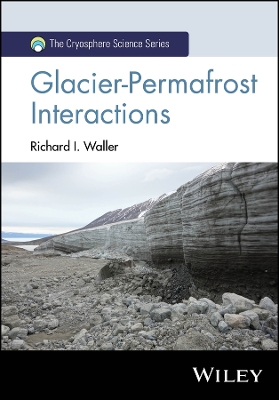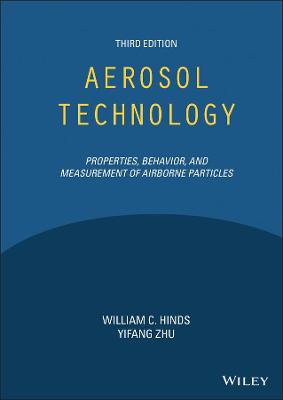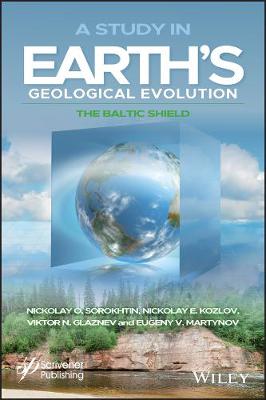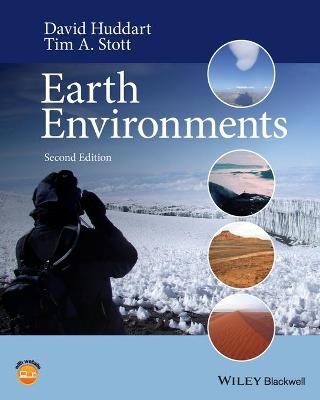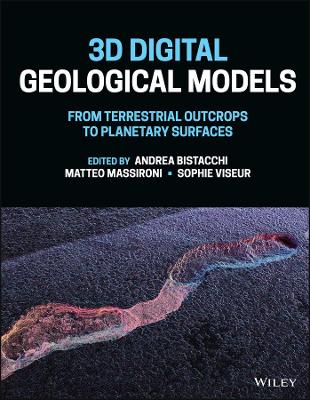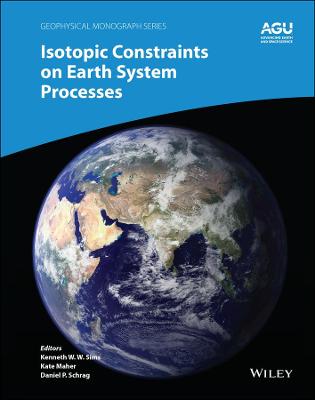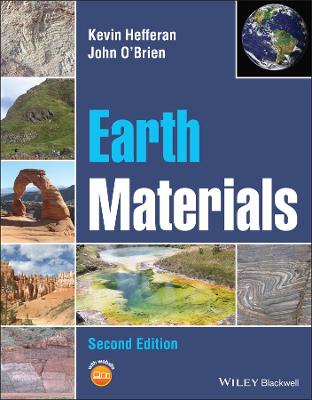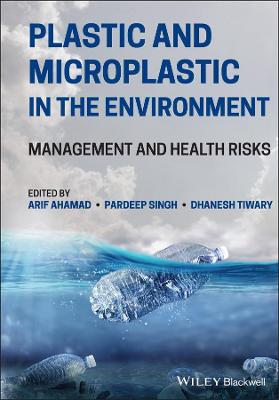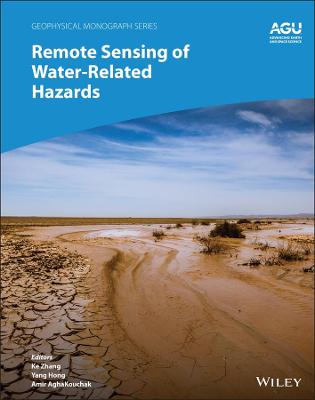Environmental Chemistry
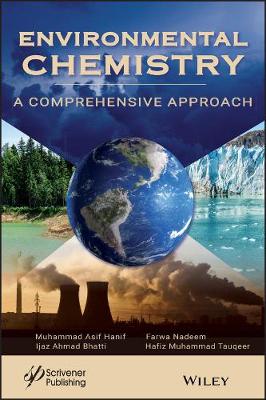 -15%
portes grátis
-15%
portes grátis
Environmental Chemistry
A Comprehensive Approach
Nadeem, Farwa; Tauqeer, Hafiz Muhammad; Bhatti, Ijaz Ahmad; Hanif, Muhammad A.
John Wiley & Sons Inc
11/2020
688
Dura
Inglês
9781119650911
15 a 20 dias
1402
1 Introduction to Environmental Chemistry 1
1.1 Beginning of the Universe 1
1.2 Plank's Time 2
1.3 Components of Solar System 3
1.4 Electromagnetic Spectrum and Solar Radiations 5
1.4.1 Types of Electromagnetic Radiations 5
1.4.1.1 Cosmic Rays 5
1.4.1.2 Gamma Rays 6
1.4.1.3 X-Rays 6
1.4.1.4 Ultra-Violet Region 6
1.4.1.5 Visible Region 7
1.4.1.6 Infra-Red Region 7
1.4.1.7 Terahertz Region 7
1.4.1.8 Microwave Region 8
1.4.1.9 Radiowave Region 8
1.5 Evolution of Environmental Segments 8
1.5.1 Evolution of Atmosphere 8
1.5.1.1 First Stage of Atmospheric Evolution 9
1.5.1.2 Second Stage of Atmospheric Evolution 9
1.5.1.3 Third Stage of Atmospheric Evolution 9
1.5.2 Evolution of Hydrosphere 10
1.5.3 Evolution of Lithosphere/Geosphere 10
1.5.4 Evolution of Biosphere 11
1.6 Environmental Segments 11
1.7 Scope of Environmental Chemistry in Modern World 12
1.7.1 Pollution 12
1.7.2 Climate Change 12
1.7.3 Global Warming 12
1.7.4 Deforestation 13
1.7.5 Overpopulation 13
1.7.6 Industrial and Household Waste 13
1.7.7 Acid Rain 13
1.7.8 Ozone Layer Depletion 14
1.7.9 Genetic Engineering 14
1.7.10 Urban Sprawl 14
1.8 Solutions of Environmental Problems 14
1.8.1 Green Chemistry 15
1.8.2 Renewable Energy Processes 15
1.8.3 Biofuels 15
1.8.4 Role of Biotechnology 16
2 Atmosphere 17
2.1 Introduction to Atmosphere 17
2.1.1 Layers of Atmosphere 18
2.1.1.1 Troposphere 18
2.1.1.2 Stratosphere 19
2.1.1.3 Mesosphere 20
2.1.1.4 Thermosphere 20
2.1.1.5 Exosphere 21
2.1.2 Importance of Atmosphere 21
2.1.3 Components of Atmosphere 22
2.1.3.1 Primary Gases 23
2.1.3.2 Greenhouse Gases (GHGs) 23
2.1.3.3 Reactive Gases 24
2.1.3.4 Aerosols 28
2.1.3.5 Deviations with Height 28
2.1.3.6 Deviations with Latitude and Season 29
2.1.3.7 Deviations with Time 30
2.2 Solar Radiations and Energy Budget 32
2.2.1 Total Radiations of Sun 32
2.2.1.1 Solar Output 32
2.2.1.2 Distance from Sun 34
2.2.1.3 Altitude of Sun 35
2.2.1.4 Day Length 35
2.2.2 Effects of Solar Radiations 35
2.2.2.1 Transference of Energy 35
2.2.2.2 Effect of Atmosphere 36
2.2.2.3 Effect of Cloud Cover 37
2.2.2.4 Effect of Latitude 37
2.2.2.5 Effect of Land and Sea 38
2.2.2.6 Effect of Elevation 40
2.2.2.7 Temperature Variations with Height 40
2.2.3 IR Radiations and Greenhouse Effects 41
2.2.4 Earth's Heat Budget 43
2.3 Atmospheric Moisture Budget 44
2.3.1 Condensation 44
2.3.2 Precipitation 44
2.3.2.1 Forms of Precipitation 45
2.3.2.2 Characteristics of Precipitation 46
2.3.2.3 Pattern of Precipitation 46
2.4 Variability of Atmosphere 47
2.4.1 Cloud Formation 47
2.4.1.1 Condensation Nuclei 47
2.4.1.2 Types of Clouds 48
2.4.1.3 Cloud Cover 54
2.4.2 Precipitation Formation 54
2.5 Reactions in Atmosphere 55
2.5.1 Photochemical Reactions 56
2.5.2 Biochemical Reactions 61
2.5.3 Acid Base Reactions 62
2.5.4 Reactions of Oxygen 63
2.5.5 Reactions of Nitrogen 66
2.5.6 Reactions of Carbon Dioxide 68
3 Air Pollution and Control Strategies 71
3.1 Introduction to Air Pollution 71
3.1.1 Particles in Atmosphere 72
3.1.2 Inorganic Air Pollutants 73
3.1.2.1 Composition of Particles 74
3.1.2.2 Fly Ash 75
3.1.2.3 Asbestos 76
3.1.2.4 Toxic Heavy Metals 77
3.1.2.5 Radioactive Particles 79
3.1.2.6 Effects of Particles 80
3.1.2.7 Water as Particulate Matter 80
3.1.3 Oxides of Carbon 81
3.1.3.1 Sources of Carbon Monoxide 81
3.1.3.2 Fate of Carbon Monoxide 82
3.1.3.3 Effects of Carbon Monoxide 82
3.1.3.4 Controlled Emissions of Carbon Monoxide 83
3.1.3.5 Sources of Carbon Dioxide 83
3.1.3.6 Natural Carbon Cycle 85
3.1.3.7 Chemical Reactions of Carbon Dioxide 85
3.1.3.8 Ozone Depletion and Greenhouse Effect 86
3.1.3.9 Impacts on Plant Growth 87
3.1.3.10 Impacts on Human Health 89
3.1.3.11 Impacts on Animals 90
3.1.3.12 Controlled Emissions of Carbon Dioxide 91
3.1.4 Oxides of Sulphur 91
3.1.4.1 Reactions of Sulphur Dioxide 92
3.1.4.2 Effects of Sulphur Dioxide on Ecosystem, Animals and Plants 94
3.1.4.3 Removal of Sulphur Dioxide 96
3.1.5 Oxides of Nitrogen 99
3.1.5.1 Reactions of Oxides of Nitrogen 101
3.1.5.2 Effects of Oxides of Nitrogen on Ecosystem, Humans and Animals 103
3.1.5.3 Removal of Oxides of Nitrogen 105
3.1.6 Acid Rain 106
3.1.6.1 Emissions of Acidified Chemicals 108
3.1.6.2 Chemical Processes 109
3.1.6.3 Acid Deposition 109
3.1.6.4 Effects of Acid Rain 110
3.1.6.5 Preventive Measures 111
3.1.7 Atmospheric Ammonia 111
3.1.8 Fluorine, Chlorine and Hydrogen Chloride 112
3.1.9 Hydrogen Sulphide, Carbonyl Sulphide and Carbon Disulphide 113
3.1.10 Organic Air Pollutants 114
3.1.10.1 Natural and Anthropogenic Sources 114
3.1.10.2 Distillation and Fractionation of Persistent Organic Pollutants (POPs) 117
3.1.11 Reactions of Aryl Hydrocarbons 117
3.1.12 Nonhydrocarbon Organic Compounds 121
3.1.12.1 Carbonyl Compounds 121
3.1.12.2 Miscellaneous Oxygen Compounds 124
3.1.12.3 Organohalides 126
3.1.12.4 Organo Sulphur Compounds 130
3.1.12.5 Organo Nitrogen Compounds 131
3.1.13 Photochemical Smog 133
3.1.14 Indoor Air Pollutants 133
3.1.15 Outdoor Air Pollutants 134
3.2 Accidents and Episodes 134
3.2.1 Smog in London, England (1952) 135
3.2.2 Radionuclides Emissions, Three Mile Island, United States (1979) 135
3.2.3 Bhopal Disaster, India (1984) 135
3.2.4 Chernobyl Legacy, Ukraine (1986) 136
3.2.5 Smog of Punjab, Pakistan/India (2016) 136
3.3 Air Pollution Control Strategies 136
3.3.1 Control of Particulates 137
3.3.2 Control of Oxides of Nitrogen 138
3.3.3 Control of Sulphur Dioxide 138
3.3.4 Control of Mercury 138
4 Hydrosphere 141
4.1 Introduction to Hydrosphere 141
4.2 Importance of Hydrosphere 142
4.3 Unique Properties of Water 142
4.3.1 Water, Ice and Vapors 143
4.3.2 Chemical Properties of Water 145
4.3.3 Reactions of Water 146
4.4 Hydrologic Cycle 148
4.5 Characteristics of Water Bodies 149
4.6 Life in Water 150
4.7 Aquatic Chemistry 151
4.8 Gases in Water 153
4.9 Alkalinity 154
4.10 Calcium and Other Metals in Water 155
4.10.1 Hydrated Metals Ions as Acids 156
4.10.2 Contents of Calcium 157
4.11 Complexation and Chelation 157
4.12 Hydrolysis and Complexation of Polyphosphates in Water 160
4.13 Complexation by Humic Substances 162
4.14 Complexation and Redox Processes 164
4.15 Oxidation-Reduction 164
4.16 Chemical Interactions Involving Solids, Gases and Water 165
4.17 Formation of Sediments 165
4.18 Colloidal Particles in Water 167
4.18.1 Occurrence of Colloids 167
4.18.2 Types of Colloidal Particles 167
4.18.3 Colloidal Stability 168
4.19 Colloidal Properties of Clays 170
4.20 Microbial Biochemistry in Water 171
4.20.1 Aquatic Biochemical Processes 172
5 Water Pollution and Treatment Technologies 173
5.1 Water Pollution 173
5.1.1 Toxic Heavy Metals 175
5.1.1.1 Cadmium (Cd) 176
5.1.1.2 Lead (Pb) 176
5.1.1.3 Mercury (Hg) 177
5.1.1.4 Beryllium (Be) 178
5.1.2 Metalloids 178
5.1.2.1 Arsenic (As) 178
5.1.2.2 Boron (B) 180
5.1.3 Organometallic Compounds 181
5.1.3.1 Organolead Compounds 181
5.1.3.2 Organonickel Compounds 182
5.1.3.3 Organomercury Compounds 182
5.1.3.4 Organoarsenic Compounds 183
5.1.3.5 Organotin Compounds 183
5.1.3.6 Organozinc Compounds 184
5.1.4 Volatile Organic Compounds 185
5.1.5 Synthetic Organic Compounds 195
5.1.6 Inorganic Compounds 203
5.1.7 Pesticides 210
5.1.7.1 Insecticides 210
5.1.7.2 Herbicides 215
5.1.7.3 Fungicides 218
5.1.7.4 Nematicides 218
5.1.7.5 Rodenticides 219
5.1.8 Persistent Organic Pollutants 219
5.1.9 Eutrophication 225
5.1.10 Acidity, Alkalinity and Salinity 225
5.1.11 Oxygen, Oxidants and Reductants 226
5.1.12 Soaps, Detergents and Detergent Builders 227
5.1.13 Radionuclides in Aquatic Environment 229
5.2 Wastewater Treatment Technologies 230
5.2.1 Water Treatment and Water Use 231
5.2.2 Municipal Wastewater Treatment 231
5.2.3 Treatment of Water for Industrial Use 232
5.2.4 Sewage/Municipal Treatment 233
5.2.4.1 Primary Waste Treatment 233
5.2.4.2 Secondary Waste Treatment by Biological Processes 234
5.2.4.3 Tertiary Waste Treatment 236
5.2.4.4 Physical-Chemical Treatment of Municipal Wastewater 237
5.2.5 Industrial Wastewater Treatment 238
5.2.6 Removal of Solids 239
5.2.7 Removal of Calcium and Magnessium 240
5.2.8 Removal of Iron and Manganese 244
5.2.9 Removal of Dissolved Organics 245
5.2.10 Removal of Herbicides 247
5.2.11 Removal of Dissolved Inorganics 247
5.2.11.1 Electrodialysis 248
5.2.11.2 Ion Exchange 249
5.2.11.3 Reverse Osmosis 250
5.2.12 Removal of Phosphorous 250
5.2.13 Removal of Nitrogen 251
5.2.14 Sludge 252
5.2.15 Water Disinfection 254
5.2.15.1 Chlorine Dioxide 256
5.2.15.2 Ozone 256
5.2.16 Natural Water Purification Processes 257
5.2.17 Industrial Wastewater Treatment by Soil 258
5.2.18 Wastewater Characteristics of Pulp and Paper Mills 259
5.2.18.1 Water Pollution by Paper and Pulp Industry 259
5.2.18.2 Suspended Solids 260
5.2.18.3 Dissolved Solids Organic Matter 260
5.2.18.4 Inorganic Matter 260
5.2.18.5 Chlorine and Chlorine-Based Materials 261
5.2.18.6 Sulfur, Hydrogen Sulfide and Sulfur Dioxide 261
5.2.19 Wastewater Treatment Technologies 262
5.2.19.1 Biological Wastewater Treatment 262
5.2.19.2 Research and Development in Pollution Control 263
5.2.20 Water Reuse and Recycling 263
5.3 Drinking Water Quality Standards 264
5.3.1 Colour of Water 264
5.3.2 Microbial Standards for Drinking Water 264
5.3.3 Taste and Odour 265
5.3.4 Turbidity 265
5.3.5 The pH of Drinking Water 266
5.3.6 Aluminium (Al) 266
5.3.7 Antimony (Sb) 267
5.3.8 Arsenic (As) 267
5.3.9 Barium (Ba) 267
5.3.10 Boron (B) 267
5.3.11 Cadmium (Cd) 268
5.3.12 Chloride (Cl) 268
5.3.13 Chromium (Cr) 268
5.3.14 Copper (Cu) 268
5.3.15 Cyanide (CN) 269
5.3.16 Fluoride (F) 269
5.3.17 Iodine (I) 269
5.3.18 Lead (Pb) 269
5.3.19 Manganese (Mn) 270
5.3.20 Mercury (Hg) 270
5.3.21 Nickel (Ni) 270
5.3.22 Nitrate and Nitrite 271
5.3.23 Selenium (Se) 271
5.3.24 Total Dissolved Solids (TDS) 271
5.3.25 Zinc (Zn) 271
5.3.26 Radioactive Material 272
5.3.27 Polynuclear Aromatic Hydrocarbons (PAHs) 272
5.3.28 Pesticides, Herbicides and Fungicides 272
5.4 Future Plan for Improved Water Quality 273
6 Lithosphere/Geosphere 275
6.1 Introduction to Lithosphere/Geosphere 275
6.2 Composition of Rocks 276
6.3 Characteristics of Igneous Rocks 278
6.3.1 Types of Igneous Rocks 279
6.3.2 Igneous Rocks and Bowen Reaction Series 280
6.4 Characteristics of Sedimentary Rocks 281
6.5 Characteristics of Metamorphic Rocks 282
6.5.1 Heat and Metamorphism 282
6.5.2 Pressure and Metamorphism 283
6.5.3 Chemical Actions of Fluids 283
6.5.4 Types of Metamorphism 283
6.5.5 Common Metamorphic Rocks 284
6.6 Structure of Earth and Isostacy 284
6.7 Plate Tectonics 285
6.8 Earthquakes 286
6.8.1 Earthquake Waves 287
6.9 Volcanism 288
6.10 Weathering 289
6.10.1 Products of Weathering 289
6.10.2 Chemical Weathering 290
6.10.3 Physical Weathering 290
6.10.4 Biological Weathering 291
6.11 Landform of Weathering 292
6.11.1 Regiolith and Soil 292
6.11.2 Limestone Landforms 292
6.11.3 Periglacial Landforms 293
6.12 Introduction to Soil 293
6.12.1 Organic Activity 294
6.12.2 Translocation 294
6.12.3 Soil Texture 294
6.12.4 Soil pH 295
6.12.5 Soil Colour 295
6.12.6 Soil Profile 296
6.13 Interaction of Lithosphere with other Spheres 296
7 Soil Pollution and Remediation Processes 299
7.1 Introduction to Soil Pollution 299
7.2 Causes of Land Pollution 302
7.3 Soil Contaminants 303
7.3.1 Organic Pollutants 303
7.3.2 Inorganic Pollutants 303
7.3.3 Persistent Organic Pollutants (POPs) 303
7.3.4 Petroleum Hydrocarbons 335
7.3.5 Radionuclides 340
7.4 Effects of Soil Pollution 341
7.4.1 Endangering Human Health 341
7.4.2 Economic Losses 341
7.4.3 Air and Water Contamination 341
7.4.4 Effect on Plant Life 342
7.4.5 Acidification 342
7.4.6 Diminished Soil Fertility 342
7.4.7 Changes in Soil Structure 342
7.4.8 Increase in Soil Salinity 343
7.5 Ecotoxicology of Soil 343
7.5.1 Role of Microorganisms in Soil 343
7.5.2 Effects of POPs on Soil 344
7.5.3 Effects of Pesticides on Soil 344
7.6 Reclamation of Contaminated Land 344
7.6.1 Ex situ Methods 345
7.6.1.1 Destructive Methods 347
7.6.1.2 Thermal Methods 349
7.6.1.3 Biological Methods 357
7.6.1.4 Physiochemical Methods 366
7.6.2 In situ Methods 376
7.6.2.1 Physical Methods 376
7.6.2.2 Chemical Methods 379
7.6.2.3 Biological Methods 382
7.6.2.4 Thermal Methods 384
7.7 Solutions to Soil Pollution 391
7.7.1 Reduced Use of Pesticides 391
7.7.2 Organic Farming 392
7.7.3 Reduced Yield Pressure 392
7.7.4 Control Grazing and Forest Management 392
7.7.5 Wind Breaks and Wind Shield 395
7.7.6 Special Pits for Dumping Wastes 395
7.7.7 Soil Binding Greases 395
7.7.8 Afforestation and Reforestation 396
7.7.9 Recycling of Materials 397
7.7.10 Solid Waste Treatment 398
8 Biosphere 399
8.1 Introduction to Biosphere 399
8.2 Extent of Earth's Biosphere 399
8.3 Components of Biosphere 400
8.4 Industrial Ecology 403
8.4.1 Industrial Ecosystem 404
8.4.2 Societal Factors and Environmental Ethics 404
8.5 Natural Cycles 405
8.5.1 Hydrologic Cycle 405
8.5.2 Carbon Cycle 406
8.5.3 Nitrogen Cycle 410
8.5.4 Sulphur Cycle 413
8.5.5 Phosphorous Cycle 415
8.5.6 Oxygen Cycle 415
8.5.7 Halogens and Organohalides 416
8.5.8 Iron Cycle 416
8.5.9 Selenium Cycle 419
8.6 Disturbances in Biosphere 419
8.7 Remote Sensing of Biosphere at NASA 424
9 Noise Pollution 427
9.1 What Is Noise Pollution? 427
9.2 Noise Sources 427
9.2.1 Typical Range of Noise Levels 427
9.2.2 Characteristics of Industrial Noise 429
9.2.2.1 Industrial Noise Sources 430
9.2.2.2 Mining and Construction Noise 431
9.2.3 Transportation Noise 432
xvi Contents
9.2.4 Urban Noise 432
9.2.5 Specific Noise Sources 434
9.3 Effects of Noise 434
9.3.1 Reactions to Noise 434
9.3.1.1 Auditory Effects 435
9.3.1.2 Permanent Threshold Shift (PTS) 435
9.3.1.3 Acoustic Trauma 436
9.3.2 Damage-Risk Criteria 436
9.3.3 Psychological Effects of Noise Pollution 436
9.3.3.1 Speech Interference 436
9.3.3.2 Annoyance 437
9.3.3.3 Sleep Interference 437
9.3.3.4 Effects on Performance 437
9.3.3.5 Acoustic Privacy 438
9.3.3.6 Subjective Responses 438
9.4 Noise Measurements 438
9.4.1 Instruments for Measuring Noise 439
9.4.2 Impacts and Impulse Magnitude 440
9.4.3 Monitoring Devices 440
9.4.4 Field Measurements 440
10 Toxicological Chemistry 443
10.1 Introduction to Toxicological Chemistry 443
10.2 Synergism, Potentiation and Antagonism 444
10.3 Dose Response Relationship 444
10.4 Relative Toxicities 444
10.5 Reversibility and Sensitivity 445
10.5.1 Hypersensitivity and Hyposensitivity 445
10.6 Xenobiotic and Endogenous Substances 445
10.7 Toxicological Chemistry 446
10.7.1 Toxicants in Body 446
10.8 Kinetic Phase and Dynamic Phase 446
10.8.1 Primary Reaction in Dynamic Phase 447
10.8.2 Biochemical Effects in Dynamic Phase 447
10.8.3 Response to Toxicants 447
10.8.4 Tetragenesis 448
10.8.5 Mutagenesis 448
10.8.6 Carcinogenesis 448
10.8.6.1 Biochemistry of Carcinogenesis 448
10.8.6.2 Alkylating Agents in Carcinogenesis 449
10.8.7 Testing for Carcinogens 449
10.8.8 Immune System Response 449
10.8.9 Estrogenic Substances 450
10.9 ATSDR Toxicological Profiles 450
10.10 Biotransformation of Xenobiotics 450
10.10.1 Basic Properties of Xenobiotic Bio-Transforming Enzymes 450
10.10.2 Biotransformation versus Metabolism 451
10.10.3 Stereochemical Aspects of Xenobiotic Biotransformation 451
10.10.4 Phase I and Phase II Biotransformation 452
10.10.5 Nomenclature of Xenobiotic Bio-Transforming Enzymes 452
10.10.6 Distribution of Xenobiotic Bio-Transforming Enzymes 452
10.10.7 Xenobiotic Biotransformation by Phase I Enzymes 452
10.10.7.1 Hydrolysis 453
10.10.7.2 Reduction 453
10.10.7.3 Oxidation 453
10.10.7.4 Activation of Xenobiotics by Cytochrome P450 454
10.10.7.5 P450 Knockout Mice 454
10.10.7.6 Inhibition of Cytochrome P450 454
10.10.7.7 Induction of Cytochrome P450 455
10.10.8 Phase II Enzyme Reactions 455
10.10.8.1 Glucuronidation 455
10.10.8.2 Sulfation 456
10.10.8.3 Methylation 456
10.10.8.4 Acetylation 456
10.10.8.5 Amino Acid Conjugation 457
10.10.8.6 Glutathione Conjugation 457
10.10.8.7 Rhodanese 457
10.10.8.8 Phosphorylation 458
10.11 Toxic Inorganic Compounds 458
10.11.1 Cyanide 458
10.11.2 Carbon Mono Oxide 459
10.11.3 Nitrogen Oxides 459
10.11.4 Hydrogen Halides 459
10.11.5 Asbestos 460
10.11.6 Inorganic Compounds of Silicon 460
10.11.7 Inorganic Phosphorous Compounds 461
10.11.8 Inorganic Compounds of Sulphur 461
10.11.9 Organo Metallic Compounds 462
10.11.9.1 Organo Lead Compounds 462
10.11.9.2 Organo Tin Compounds 462
10.12 Toxicology of Organic Compounds 463
10.12.1 Alkane Hydrocarbon 463
10.12.2 Alkene and Alkyne Hydrocarbons 463
10.12.3 Benzene and Aromatic Hydrocarbon 464
10.12.4 Oxygen Containing Organic Compounds 464
10.12.5 Organo Nitrogen Compounds 465
10.12.6 Organo Halide Compounds 466
10.12.7 Organo Halide Pesticide 466
10.12.8 Organo Sulphur Compounds 467
10.12.9 Organo Phosphorous Compounds 467
11 Environmental Disasters 469
11.1 Introduction to Environmental Disasters 469
11.2 Types of Environmental Disasters 469
11.2.1 Agricultural Disasters 469
11.2.2 Biodiversity Disasters 470
11.2.3 Industrial Disasters 470
11.2.4 Human Health Disasters 470
11.2.5 Natural Disasters 470
11.2.6 Nuclear Disasters 470
11.2.7 Geo-Hydrological Disasters 471
11.2.8 Climate Change and Disasters 472
11.3 Historical Environmental Disasters 472
11.3.1 "Fat Man" and "Little Boy" Attack on Japan (1945) 472
11.3.2 Plant Emissions in Donora, Penn., U.S. (1948) 473
11.3.3 Four-Day Fog in London, England (1952) 473
11.3.4 Love Canal, Niagara Falls, New York (1953) 474
11.3.5 New York Smog (1966) 474
11.3.6 Smiling Buddha Indian Nuclear Test (1974) 475
11.3.7 Release of Methyl Isocynate in Bhopal, India (1984) 475
11.3.8 Radionuclide Releases, Chernobyl, Ukraine (1986) 476
11.3.9 Air Pollution Asia (2016) 477
11.3.10 Fuel Tanker Explosion, Bahawalpur, Pakistan (2017) 477
11.3.11 Beirut Explosion, Lebanon (2020) 478
12 Hazardous Wastes 479
12.1 Introduction to Hazardous Wastes 479
12.2 Classification of Hazardous Wastes 479
12.3 Characteristics of Hazardous Wastes 480
12.4 Types of Wastes 495
12.4.1 Radionuclides/Nuclear Waste 526
12.4.2 Chemical Waste 527
12.4.3 Biological Waste 527
12.5 Hazardous Waste Management 528
12.5.1 Radionuclide/Nuclear Waste Management 528
12.5.2 Chemical Waste Management 529
12.5.3 Biological Waste Management 529
13 Non-Renewable Energy Resources 531
13.1 What Is Energy? 531
13.2 Types of Energy 532
13.3 Natural Gas 533
13.3.1 Global Statistics 533
13.3.2 Historical Perspective 534
13.3.3 Chemical Composition 535
13.3.4 Process of Formation of Natural Gas 535
13.3.5 Generation and Transmission of Electricity 536
13.3.6 What Is LNG? 537
13.3.7 Advantages and Disadvantages 537
13.4 Coal 538
13.4.1 Global Trends in Coal 538
13.4.2 Historical Milestones 538
13.4.3 Types of Coal 539
13.4.4 Process of Coal Formation 540
13.4.5 Electricity Production from Coal Power Plant 540
13.4.6 Coal in Steel Production 540
13.4.7 Coal Liquification 541
13.4.8 Coal and Cement 542
13.4.9 Advantages and Disadvantages 542
13.5 Petroleum 543
13.5.1 Global Petroleum Reserves 543
13.5.2 Historical Perspective 544
13.5.3 Chemistry of Petroleum 544
13.5.4 Classification of Crude Oil 545
13.5.5 Process of Formation 545
13.5.6 Worldwide Applications of Petroleum 546
13.5.7 Advantages and Disadvantages 546
13.6 Nuclear Energy 547
13.6.1 Nuclear Fusion 547
13.6.2 Nuclear Fission 549
13.6.3 Nuclear Reactor 550
13.6.4 Generation of Electricity from Nuclear Energy 550
13.6.5 Global Statistical Perspective 552
13.6.6 Future Demands of Nuclear Energy 552
13.6.7 Advantages and Disadvantages 553
14 Renewable Energy Resources 555
14.1 Introduction to Renewable Energy Resources 555
14.2 Wind Energy 556
14.2.1 History of Wind Energy 557
14.2.2 World Wind Energy Statistics 558
14.2.3 Types of Wind Turbines 558
14.2.3.1 Horizontal Axis Wind Turbine 559
14.2.3.2 Vertical Axis Wind Turbine 560
14.2.3.3 Ducted Wind Turbines 560
14.2.4 Method of Electricity Generation from Wind Energy 561
14.2.5 Importance of Area Selection for Wind Energy 562
14.2.6 Advantages and Disadvantages 562
14.3 Solar Energy 563
14.3.1 Historical Perspective 563
14.3.2 Global Statistics 564
14.3.3 Types of Solar Cells 565
14.3.3.1 Amorphous Silicon Solar Cell 565
14.3.3.2 Crystalline Silicon Solar Cell 565
14.3.3.3 Monocrystalline Solar Cell 566
14.3.3.4 Polycrystalline Solar Cell 566
14.3.3.5 Thin Film Solar Cell 567
14.3.4 Working Principle of Solar Energy System 567
14.3.5 Advantages and Disadvantages 569
14.4 Water-Derived Energy 569
14.4.1 Tidal Power 569
14.4.2 Wave Power 570
14.4.3 Ocean Thermal Energy Conversion 570
14.4.4 Method of Generation of Electricity 571
14.4.5 Advantages and Disadvantages 572
14.5 Geothermal Energy 572
14.5.1 Brief History 573
14.5.2 Statistical Interpretation 573
14.5.3 Principles of Electricity Generation 574
14.5.4 Geysers 575
14.5.5 Flash Steam Geothermal Power Plant 576
14.5.6 Binary Cycle Geothermal Power Plant 576
14.5.7 Advantages and Disadvantages 577
14.6 Fuel Cells 577
14.6.1 History of Fuel Cells 577
14.6.2 Types of Fuel Cells 578
14.6.2.1 Alkaline Fuel Cells (AFC) 578
14.6.2.2 Molten Carbonate Fuel Cells (MCFC) 578
14.6.2.3 Phosphoric Acid Fuel Cells (PAFC) 579
14.6.2.4 Polymer Electrolyte Membrane Fuel Cells (PEMFC) 579
14.6.2.5 Solid Oxide Fuel Cells (SOFC) 580
14.6.3 Working Principle of Fuel Cell 580
14.6.4 Advantages and Disadvantages 581
15 Biofuels 583
15.1 Introduction to Biofuels 583
15.2 Properties of Biofuels 584
15.2.1 Molecular Structure 584
15.2.2 Physical Properties 584
15.2.3 Chemical Properties 585
15.3 Potential of Biomass 586
15.4 Biofuel Standardization 587
15.5 Types of Biofuels 587
15.5.1 First-Generation Biofuels 588
15.5.2 Second-Generation Biofuels 588
15.5.3 Third-Generation Biofuels 589
15.6 Bioethanol 589
15.6.1 Food Stock Production 589
15.6.1.1 Sugar Crops 590
15.6.1.2 Starch Crops 592
15.6.1.3 Cellulosic Feedstock 593
15.6.2 Bioethanol Production 593
15.6.2.1 Sugar to Ethanol Process 594
15.6.2.2 Starch to Ethanol Process 594
15.6.2.3 Cellulose to Ethanol Process 595
15.6.2.4 Distillation and Dehydration Process 596
15.6.3 Properties of Bioethanol 596
15.6.4 Technology Applications of Bioethanol 597
15.6.4.1 Spark Ignition Engines 597
15.6.4.2 Fuel Cells 597
15.6.5 Standardization of Bioethanol 598
15.6.6 Energy Balance of Bioethanol 598
15.6.7 Bioethanol Emissions 599
15.6.7.1 Green House Emissions 599
15.6.7.2 Toxic Exhaust Emissions 600
15.6.8 Other Environmental Aspects of Bioethanol 600
15.6.8.1 Water Issues 600
15.6.8.2 Land Use and Biodiversity 601
15.6.8.3 Human Health 602
15.6.9 Economy of Bioethanol 602
15.7 Lipid-Derived Biofuels 603
15.7.1 Feedstock Production 603
15.7.1.1 Oil Seed Crops 604
15.7.1.2 Microalgae 606
15.7.1.3 Animal Fats 607
15.7.1.4 Waste Oils 608
15.7.2 Fuel Production 608
15.7.2.1 Oil Extraction 609
15.7.2.2 Oil Refining 610
15.7.2.3 Trans Esterification 611
15.7.3 Properties and Use of Lipid Biofuels 612
15.7.3.1 Properties of Pure Plant Oil 612
15.7.3.2 Properties of Biodiesel 613
15.7.4 Technology Applications of Lipid Biofuels 614
15.7.4.1 Compression Ignition Engine for Biodiesel Use 614
15.7.4.2 Compression Ignition Engine for PPO Use 615
15.7.5 Standardization of Lipid Biofuels 615
15.7.5.1 Standardization of PPO 615
15.7.5.2 Standardization of Biodiesel 615
15.7.7 Emission of Lipid Biofuels 617
15.7.7.1 Greenhouse Gas Emissions 617
15.7.7.2 Toxic Exhaust Emissions 618
15.7.8 Other Environmental Impacts of Lipid Biofuels 618
15.7.8.1 Water Issues 619
15.7.8.2 Land Use and Biodiversity 619
15.7.8.3 Human Health 620
xxii Contents
15.7.9 Economy of Lipid Biofuels 620
15.8 BtL Fuels 621
15.8.1 Feedstock Production 621
15.8.2 BtL Production 622
15.8.2.1 Gasification 622
15.8.2.2 Gas Cleaning 623
15.8.2.3 Synthesis Process 623
15.8.3 Properties and Emissions of BtL Fuels 624
15.9 Biomethane 624
15.9.1 Feedstock Production 624
15.9.2 Biomethane Production 625
15.9.2.1 Digestion Process 625
15.9.2.2 Digestion Types 626
15.9.2.3 Biogas Purification 627
15.9.3 Properties and Use of Biomethane 627
15.9.4 Technology Applications of Biomethane 627
15.9.4.1 Infrastructure Requirements for Biomethane 627
15.9.4.2 Vehicle Technologies for Biomethane 628
15.9.5 Standardization of Biomethane 628
15.9.6 Biomethane Emissions 629
15.9.6.1 Greenhouse Gas Emissions 629
15.9.6.2 Toxic Exhaust Emissions 629
15.9.7 Other Environmental Effects of Biomethane 629
15.9.8 Economy of Biomethane 630
15.10 Biohydrogen 630
15.10.1 Biohydrogen Processing 630
15.10.2 Use of Biohydrogen 632
15.11 Biomass Conversion Inhibitors and in situ Detoxification 632
15.11.1 Introduction to Inhibitors 632
15.11.2 Inhibitory Compounds Derived from Biomass Pretreatment 633
15.11.3 Inhibitory Effects 635
15.11.4 Removal of Inhibitors 636
15.11.5 Inhibitor Tolerant Strain Development 637
15.11.6 Inhibitor Conversion Pathways 638
15.11.7 Molecular Mechanism of in situ Detoxification 639
15.12 Policies in Biofuel 642
15.13 Strategies for New Vehicle Technologies 643
15.14 Market Barriers of Biofuels 644
About the Authors 647
Index 649
1 Introduction to Environmental Chemistry 1
1.1 Beginning of the Universe 1
1.2 Plank's Time 2
1.3 Components of Solar System 3
1.4 Electromagnetic Spectrum and Solar Radiations 5
1.4.1 Types of Electromagnetic Radiations 5
1.4.1.1 Cosmic Rays 5
1.4.1.2 Gamma Rays 6
1.4.1.3 X-Rays 6
1.4.1.4 Ultra-Violet Region 6
1.4.1.5 Visible Region 7
1.4.1.6 Infra-Red Region 7
1.4.1.7 Terahertz Region 7
1.4.1.8 Microwave Region 8
1.4.1.9 Radiowave Region 8
1.5 Evolution of Environmental Segments 8
1.5.1 Evolution of Atmosphere 8
1.5.1.1 First Stage of Atmospheric Evolution 9
1.5.1.2 Second Stage of Atmospheric Evolution 9
1.5.1.3 Third Stage of Atmospheric Evolution 9
1.5.2 Evolution of Hydrosphere 10
1.5.3 Evolution of Lithosphere/Geosphere 10
1.5.4 Evolution of Biosphere 11
1.6 Environmental Segments 11
1.7 Scope of Environmental Chemistry in Modern World 12
1.7.1 Pollution 12
1.7.2 Climate Change 12
1.7.3 Global Warming 12
1.7.4 Deforestation 13
1.7.5 Overpopulation 13
1.7.6 Industrial and Household Waste 13
1.7.7 Acid Rain 13
1.7.8 Ozone Layer Depletion 14
1.7.9 Genetic Engineering 14
1.7.10 Urban Sprawl 14
1.8 Solutions of Environmental Problems 14
1.8.1 Green Chemistry 15
1.8.2 Renewable Energy Processes 15
1.8.3 Biofuels 15
1.8.4 Role of Biotechnology 16
2 Atmosphere 17
2.1 Introduction to Atmosphere 17
2.1.1 Layers of Atmosphere 18
2.1.1.1 Troposphere 18
2.1.1.2 Stratosphere 19
2.1.1.3 Mesosphere 20
2.1.1.4 Thermosphere 20
2.1.1.5 Exosphere 21
2.1.2 Importance of Atmosphere 21
2.1.3 Components of Atmosphere 22
2.1.3.1 Primary Gases 23
2.1.3.2 Greenhouse Gases (GHGs) 23
2.1.3.3 Reactive Gases 24
2.1.3.4 Aerosols 28
2.1.3.5 Deviations with Height 28
2.1.3.6 Deviations with Latitude and Season 29
2.1.3.7 Deviations with Time 30
2.2 Solar Radiations and Energy Budget 32
2.2.1 Total Radiations of Sun 32
2.2.1.1 Solar Output 32
2.2.1.2 Distance from Sun 34
2.2.1.3 Altitude of Sun 35
2.2.1.4 Day Length 35
2.2.2 Effects of Solar Radiations 35
2.2.2.1 Transference of Energy 35
2.2.2.2 Effect of Atmosphere 36
2.2.2.3 Effect of Cloud Cover 37
2.2.2.4 Effect of Latitude 37
2.2.2.5 Effect of Land and Sea 38
2.2.2.6 Effect of Elevation 40
2.2.2.7 Temperature Variations with Height 40
2.2.3 IR Radiations and Greenhouse Effects 41
2.2.4 Earth's Heat Budget 43
2.3 Atmospheric Moisture Budget 44
2.3.1 Condensation 44
2.3.2 Precipitation 44
2.3.2.1 Forms of Precipitation 45
2.3.2.2 Characteristics of Precipitation 46
2.3.2.3 Pattern of Precipitation 46
2.4 Variability of Atmosphere 47
2.4.1 Cloud Formation 47
2.4.1.1 Condensation Nuclei 47
2.4.1.2 Types of Clouds 48
2.4.1.3 Cloud Cover 54
2.4.2 Precipitation Formation 54
2.5 Reactions in Atmosphere 55
2.5.1 Photochemical Reactions 56
2.5.2 Biochemical Reactions 61
2.5.3 Acid Base Reactions 62
2.5.4 Reactions of Oxygen 63
2.5.5 Reactions of Nitrogen 66
2.5.6 Reactions of Carbon Dioxide 68
3 Air Pollution and Control Strategies 71
3.1 Introduction to Air Pollution 71
3.1.1 Particles in Atmosphere 72
3.1.2 Inorganic Air Pollutants 73
3.1.2.1 Composition of Particles 74
3.1.2.2 Fly Ash 75
3.1.2.3 Asbestos 76
3.1.2.4 Toxic Heavy Metals 77
3.1.2.5 Radioactive Particles 79
3.1.2.6 Effects of Particles 80
3.1.2.7 Water as Particulate Matter 80
3.1.3 Oxides of Carbon 81
3.1.3.1 Sources of Carbon Monoxide 81
3.1.3.2 Fate of Carbon Monoxide 82
3.1.3.3 Effects of Carbon Monoxide 82
3.1.3.4 Controlled Emissions of Carbon Monoxide 83
3.1.3.5 Sources of Carbon Dioxide 83
3.1.3.6 Natural Carbon Cycle 85
3.1.3.7 Chemical Reactions of Carbon Dioxide 85
3.1.3.8 Ozone Depletion and Greenhouse Effect 86
3.1.3.9 Impacts on Plant Growth 87
3.1.3.10 Impacts on Human Health 89
3.1.3.11 Impacts on Animals 90
3.1.3.12 Controlled Emissions of Carbon Dioxide 91
3.1.4 Oxides of Sulphur 91
3.1.4.1 Reactions of Sulphur Dioxide 92
3.1.4.2 Effects of Sulphur Dioxide on Ecosystem, Animals and Plants 94
3.1.4.3 Removal of Sulphur Dioxide 96
3.1.5 Oxides of Nitrogen 99
3.1.5.1 Reactions of Oxides of Nitrogen 101
3.1.5.2 Effects of Oxides of Nitrogen on Ecosystem, Humans and Animals 103
3.1.5.3 Removal of Oxides of Nitrogen 105
3.1.6 Acid Rain 106
3.1.6.1 Emissions of Acidified Chemicals 108
3.1.6.2 Chemical Processes 109
3.1.6.3 Acid Deposition 109
3.1.6.4 Effects of Acid Rain 110
3.1.6.5 Preventive Measures 111
3.1.7 Atmospheric Ammonia 111
3.1.8 Fluorine, Chlorine and Hydrogen Chloride 112
3.1.9 Hydrogen Sulphide, Carbonyl Sulphide and Carbon Disulphide 113
3.1.10 Organic Air Pollutants 114
3.1.10.1 Natural and Anthropogenic Sources 114
3.1.10.2 Distillation and Fractionation of Persistent Organic Pollutants (POPs) 117
3.1.11 Reactions of Aryl Hydrocarbons 117
3.1.12 Nonhydrocarbon Organic Compounds 121
3.1.12.1 Carbonyl Compounds 121
3.1.12.2 Miscellaneous Oxygen Compounds 124
3.1.12.3 Organohalides 126
3.1.12.4 Organo Sulphur Compounds 130
3.1.12.5 Organo Nitrogen Compounds 131
3.1.13 Photochemical Smog 133
3.1.14 Indoor Air Pollutants 133
3.1.15 Outdoor Air Pollutants 134
3.2 Accidents and Episodes 134
3.2.1 Smog in London, England (1952) 135
3.2.2 Radionuclides Emissions, Three Mile Island, United States (1979) 135
3.2.3 Bhopal Disaster, India (1984) 135
3.2.4 Chernobyl Legacy, Ukraine (1986) 136
3.2.5 Smog of Punjab, Pakistan/India (2016) 136
3.3 Air Pollution Control Strategies 136
3.3.1 Control of Particulates 137
3.3.2 Control of Oxides of Nitrogen 138
3.3.3 Control of Sulphur Dioxide 138
3.3.4 Control of Mercury 138
4 Hydrosphere 141
4.1 Introduction to Hydrosphere 141
4.2 Importance of Hydrosphere 142
4.3 Unique Properties of Water 142
4.3.1 Water, Ice and Vapors 143
4.3.2 Chemical Properties of Water 145
4.3.3 Reactions of Water 146
4.4 Hydrologic Cycle 148
4.5 Characteristics of Water Bodies 149
4.6 Life in Water 150
4.7 Aquatic Chemistry 151
4.8 Gases in Water 153
4.9 Alkalinity 154
4.10 Calcium and Other Metals in Water 155
4.10.1 Hydrated Metals Ions as Acids 156
4.10.2 Contents of Calcium 157
4.11 Complexation and Chelation 157
4.12 Hydrolysis and Complexation of Polyphosphates in Water 160
4.13 Complexation by Humic Substances 162
4.14 Complexation and Redox Processes 164
4.15 Oxidation-Reduction 164
4.16 Chemical Interactions Involving Solids, Gases and Water 165
4.17 Formation of Sediments 165
4.18 Colloidal Particles in Water 167
4.18.1 Occurrence of Colloids 167
4.18.2 Types of Colloidal Particles 167
4.18.3 Colloidal Stability 168
4.19 Colloidal Properties of Clays 170
4.20 Microbial Biochemistry in Water 171
4.20.1 Aquatic Biochemical Processes 172
5 Water Pollution and Treatment Technologies 173
5.1 Water Pollution 173
5.1.1 Toxic Heavy Metals 175
5.1.1.1 Cadmium (Cd) 176
5.1.1.2 Lead (Pb) 176
5.1.1.3 Mercury (Hg) 177
5.1.1.4 Beryllium (Be) 178
5.1.2 Metalloids 178
5.1.2.1 Arsenic (As) 178
5.1.2.2 Boron (B) 180
5.1.3 Organometallic Compounds 181
5.1.3.1 Organolead Compounds 181
5.1.3.2 Organonickel Compounds 182
5.1.3.3 Organomercury Compounds 182
5.1.3.4 Organoarsenic Compounds 183
5.1.3.5 Organotin Compounds 183
5.1.3.6 Organozinc Compounds 184
5.1.4 Volatile Organic Compounds 185
5.1.5 Synthetic Organic Compounds 195
5.1.6 Inorganic Compounds 203
5.1.7 Pesticides 210
5.1.7.1 Insecticides 210
5.1.7.2 Herbicides 215
5.1.7.3 Fungicides 218
5.1.7.4 Nematicides 218
5.1.7.5 Rodenticides 219
5.1.8 Persistent Organic Pollutants 219
5.1.9 Eutrophication 225
5.1.10 Acidity, Alkalinity and Salinity 225
5.1.11 Oxygen, Oxidants and Reductants 226
5.1.12 Soaps, Detergents and Detergent Builders 227
5.1.13 Radionuclides in Aquatic Environment 229
5.2 Wastewater Treatment Technologies 230
5.2.1 Water Treatment and Water Use 231
5.2.2 Municipal Wastewater Treatment 231
5.2.3 Treatment of Water for Industrial Use 232
5.2.4 Sewage/Municipal Treatment 233
5.2.4.1 Primary Waste Treatment 233
5.2.4.2 Secondary Waste Treatment by Biological Processes 234
5.2.4.3 Tertiary Waste Treatment 236
5.2.4.4 Physical-Chemical Treatment of Municipal Wastewater 237
5.2.5 Industrial Wastewater Treatment 238
5.2.6 Removal of Solids 239
5.2.7 Removal of Calcium and Magnessium 240
5.2.8 Removal of Iron and Manganese 244
5.2.9 Removal of Dissolved Organics 245
5.2.10 Removal of Herbicides 247
5.2.11 Removal of Dissolved Inorganics 247
5.2.11.1 Electrodialysis 248
5.2.11.2 Ion Exchange 249
5.2.11.3 Reverse Osmosis 250
5.2.12 Removal of Phosphorous 250
5.2.13 Removal of Nitrogen 251
5.2.14 Sludge 252
5.2.15 Water Disinfection 254
5.2.15.1 Chlorine Dioxide 256
5.2.15.2 Ozone 256
5.2.16 Natural Water Purification Processes 257
5.2.17 Industrial Wastewater Treatment by Soil 258
5.2.18 Wastewater Characteristics of Pulp and Paper Mills 259
5.2.18.1 Water Pollution by Paper and Pulp Industry 259
5.2.18.2 Suspended Solids 260
5.2.18.3 Dissolved Solids Organic Matter 260
5.2.18.4 Inorganic Matter 260
5.2.18.5 Chlorine and Chlorine-Based Materials 261
5.2.18.6 Sulfur, Hydrogen Sulfide and Sulfur Dioxide 261
5.2.19 Wastewater Treatment Technologies 262
5.2.19.1 Biological Wastewater Treatment 262
5.2.19.2 Research and Development in Pollution Control 263
5.2.20 Water Reuse and Recycling 263
5.3 Drinking Water Quality Standards 264
5.3.1 Colour of Water 264
5.3.2 Microbial Standards for Drinking Water 264
5.3.3 Taste and Odour 265
5.3.4 Turbidity 265
5.3.5 The pH of Drinking Water 266
5.3.6 Aluminium (Al) 266
5.3.7 Antimony (Sb) 267
5.3.8 Arsenic (As) 267
5.3.9 Barium (Ba) 267
5.3.10 Boron (B) 267
5.3.11 Cadmium (Cd) 268
5.3.12 Chloride (Cl) 268
5.3.13 Chromium (Cr) 268
5.3.14 Copper (Cu) 268
5.3.15 Cyanide (CN) 269
5.3.16 Fluoride (F) 269
5.3.17 Iodine (I) 269
5.3.18 Lead (Pb) 269
5.3.19 Manganese (Mn) 270
5.3.20 Mercury (Hg) 270
5.3.21 Nickel (Ni) 270
5.3.22 Nitrate and Nitrite 271
5.3.23 Selenium (Se) 271
5.3.24 Total Dissolved Solids (TDS) 271
5.3.25 Zinc (Zn) 271
5.3.26 Radioactive Material 272
5.3.27 Polynuclear Aromatic Hydrocarbons (PAHs) 272
5.3.28 Pesticides, Herbicides and Fungicides 272
5.4 Future Plan for Improved Water Quality 273
6 Lithosphere/Geosphere 275
6.1 Introduction to Lithosphere/Geosphere 275
6.2 Composition of Rocks 276
6.3 Characteristics of Igneous Rocks 278
6.3.1 Types of Igneous Rocks 279
6.3.2 Igneous Rocks and Bowen Reaction Series 280
6.4 Characteristics of Sedimentary Rocks 281
6.5 Characteristics of Metamorphic Rocks 282
6.5.1 Heat and Metamorphism 282
6.5.2 Pressure and Metamorphism 283
6.5.3 Chemical Actions of Fluids 283
6.5.4 Types of Metamorphism 283
6.5.5 Common Metamorphic Rocks 284
6.6 Structure of Earth and Isostacy 284
6.7 Plate Tectonics 285
6.8 Earthquakes 286
6.8.1 Earthquake Waves 287
6.9 Volcanism 288
6.10 Weathering 289
6.10.1 Products of Weathering 289
6.10.2 Chemical Weathering 290
6.10.3 Physical Weathering 290
6.10.4 Biological Weathering 291
6.11 Landform of Weathering 292
6.11.1 Regiolith and Soil 292
6.11.2 Limestone Landforms 292
6.11.3 Periglacial Landforms 293
6.12 Introduction to Soil 293
6.12.1 Organic Activity 294
6.12.2 Translocation 294
6.12.3 Soil Texture 294
6.12.4 Soil pH 295
6.12.5 Soil Colour 295
6.12.6 Soil Profile 296
6.13 Interaction of Lithosphere with other Spheres 296
7 Soil Pollution and Remediation Processes 299
7.1 Introduction to Soil Pollution 299
7.2 Causes of Land Pollution 302
7.3 Soil Contaminants 303
7.3.1 Organic Pollutants 303
7.3.2 Inorganic Pollutants 303
7.3.3 Persistent Organic Pollutants (POPs) 303
7.3.4 Petroleum Hydrocarbons 335
7.3.5 Radionuclides 340
7.4 Effects of Soil Pollution 341
7.4.1 Endangering Human Health 341
7.4.2 Economic Losses 341
7.4.3 Air and Water Contamination 341
7.4.4 Effect on Plant Life 342
7.4.5 Acidification 342
7.4.6 Diminished Soil Fertility 342
7.4.7 Changes in Soil Structure 342
7.4.8 Increase in Soil Salinity 343
7.5 Ecotoxicology of Soil 343
7.5.1 Role of Microorganisms in Soil 343
7.5.2 Effects of POPs on Soil 344
7.5.3 Effects of Pesticides on Soil 344
7.6 Reclamation of Contaminated Land 344
7.6.1 Ex situ Methods 345
7.6.1.1 Destructive Methods 347
7.6.1.2 Thermal Methods 349
7.6.1.3 Biological Methods 357
7.6.1.4 Physiochemical Methods 366
7.6.2 In situ Methods 376
7.6.2.1 Physical Methods 376
7.6.2.2 Chemical Methods 379
7.6.2.3 Biological Methods 382
7.6.2.4 Thermal Methods 384
7.7 Solutions to Soil Pollution 391
7.7.1 Reduced Use of Pesticides 391
7.7.2 Organic Farming 392
7.7.3 Reduced Yield Pressure 392
7.7.4 Control Grazing and Forest Management 392
7.7.5 Wind Breaks and Wind Shield 395
7.7.6 Special Pits for Dumping Wastes 395
7.7.7 Soil Binding Greases 395
7.7.8 Afforestation and Reforestation 396
7.7.9 Recycling of Materials 397
7.7.10 Solid Waste Treatment 398
8 Biosphere 399
8.1 Introduction to Biosphere 399
8.2 Extent of Earth's Biosphere 399
8.3 Components of Biosphere 400
8.4 Industrial Ecology 403
8.4.1 Industrial Ecosystem 404
8.4.2 Societal Factors and Environmental Ethics 404
8.5 Natural Cycles 405
8.5.1 Hydrologic Cycle 405
8.5.2 Carbon Cycle 406
8.5.3 Nitrogen Cycle 410
8.5.4 Sulphur Cycle 413
8.5.5 Phosphorous Cycle 415
8.5.6 Oxygen Cycle 415
8.5.7 Halogens and Organohalides 416
8.5.8 Iron Cycle 416
8.5.9 Selenium Cycle 419
8.6 Disturbances in Biosphere 419
8.7 Remote Sensing of Biosphere at NASA 424
9 Noise Pollution 427
9.1 What Is Noise Pollution? 427
9.2 Noise Sources 427
9.2.1 Typical Range of Noise Levels 427
9.2.2 Characteristics of Industrial Noise 429
9.2.2.1 Industrial Noise Sources 430
9.2.2.2 Mining and Construction Noise 431
9.2.3 Transportation Noise 432
xvi Contents
9.2.4 Urban Noise 432
9.2.5 Specific Noise Sources 434
9.3 Effects of Noise 434
9.3.1 Reactions to Noise 434
9.3.1.1 Auditory Effects 435
9.3.1.2 Permanent Threshold Shift (PTS) 435
9.3.1.3 Acoustic Trauma 436
9.3.2 Damage-Risk Criteria 436
9.3.3 Psychological Effects of Noise Pollution 436
9.3.3.1 Speech Interference 436
9.3.3.2 Annoyance 437
9.3.3.3 Sleep Interference 437
9.3.3.4 Effects on Performance 437
9.3.3.5 Acoustic Privacy 438
9.3.3.6 Subjective Responses 438
9.4 Noise Measurements 438
9.4.1 Instruments for Measuring Noise 439
9.4.2 Impacts and Impulse Magnitude 440
9.4.3 Monitoring Devices 440
9.4.4 Field Measurements 440
10 Toxicological Chemistry 443
10.1 Introduction to Toxicological Chemistry 443
10.2 Synergism, Potentiation and Antagonism 444
10.3 Dose Response Relationship 444
10.4 Relative Toxicities 444
10.5 Reversibility and Sensitivity 445
10.5.1 Hypersensitivity and Hyposensitivity 445
10.6 Xenobiotic and Endogenous Substances 445
10.7 Toxicological Chemistry 446
10.7.1 Toxicants in Body 446
10.8 Kinetic Phase and Dynamic Phase 446
10.8.1 Primary Reaction in Dynamic Phase 447
10.8.2 Biochemical Effects in Dynamic Phase 447
10.8.3 Response to Toxicants 447
10.8.4 Tetragenesis 448
10.8.5 Mutagenesis 448
10.8.6 Carcinogenesis 448
10.8.6.1 Biochemistry of Carcinogenesis 448
10.8.6.2 Alkylating Agents in Carcinogenesis 449
10.8.7 Testing for Carcinogens 449
10.8.8 Immune System Response 449
10.8.9 Estrogenic Substances 450
10.9 ATSDR Toxicological Profiles 450
10.10 Biotransformation of Xenobiotics 450
10.10.1 Basic Properties of Xenobiotic Bio-Transforming Enzymes 450
10.10.2 Biotransformation versus Metabolism 451
10.10.3 Stereochemical Aspects of Xenobiotic Biotransformation 451
10.10.4 Phase I and Phase II Biotransformation 452
10.10.5 Nomenclature of Xenobiotic Bio-Transforming Enzymes 452
10.10.6 Distribution of Xenobiotic Bio-Transforming Enzymes 452
10.10.7 Xenobiotic Biotransformation by Phase I Enzymes 452
10.10.7.1 Hydrolysis 453
10.10.7.2 Reduction 453
10.10.7.3 Oxidation 453
10.10.7.4 Activation of Xenobiotics by Cytochrome P450 454
10.10.7.5 P450 Knockout Mice 454
10.10.7.6 Inhibition of Cytochrome P450 454
10.10.7.7 Induction of Cytochrome P450 455
10.10.8 Phase II Enzyme Reactions 455
10.10.8.1 Glucuronidation 455
10.10.8.2 Sulfation 456
10.10.8.3 Methylation 456
10.10.8.4 Acetylation 456
10.10.8.5 Amino Acid Conjugation 457
10.10.8.6 Glutathione Conjugation 457
10.10.8.7 Rhodanese 457
10.10.8.8 Phosphorylation 458
10.11 Toxic Inorganic Compounds 458
10.11.1 Cyanide 458
10.11.2 Carbon Mono Oxide 459
10.11.3 Nitrogen Oxides 459
10.11.4 Hydrogen Halides 459
10.11.5 Asbestos 460
10.11.6 Inorganic Compounds of Silicon 460
10.11.7 Inorganic Phosphorous Compounds 461
10.11.8 Inorganic Compounds of Sulphur 461
10.11.9 Organo Metallic Compounds 462
10.11.9.1 Organo Lead Compounds 462
10.11.9.2 Organo Tin Compounds 462
10.12 Toxicology of Organic Compounds 463
10.12.1 Alkane Hydrocarbon 463
10.12.2 Alkene and Alkyne Hydrocarbons 463
10.12.3 Benzene and Aromatic Hydrocarbon 464
10.12.4 Oxygen Containing Organic Compounds 464
10.12.5 Organo Nitrogen Compounds 465
10.12.6 Organo Halide Compounds 466
10.12.7 Organo Halide Pesticide 466
10.12.8 Organo Sulphur Compounds 467
10.12.9 Organo Phosphorous Compounds 467
11 Environmental Disasters 469
11.1 Introduction to Environmental Disasters 469
11.2 Types of Environmental Disasters 469
11.2.1 Agricultural Disasters 469
11.2.2 Biodiversity Disasters 470
11.2.3 Industrial Disasters 470
11.2.4 Human Health Disasters 470
11.2.5 Natural Disasters 470
11.2.6 Nuclear Disasters 470
11.2.7 Geo-Hydrological Disasters 471
11.2.8 Climate Change and Disasters 472
11.3 Historical Environmental Disasters 472
11.3.1 "Fat Man" and "Little Boy" Attack on Japan (1945) 472
11.3.2 Plant Emissions in Donora, Penn., U.S. (1948) 473
11.3.3 Four-Day Fog in London, England (1952) 473
11.3.4 Love Canal, Niagara Falls, New York (1953) 474
11.3.5 New York Smog (1966) 474
11.3.6 Smiling Buddha Indian Nuclear Test (1974) 475
11.3.7 Release of Methyl Isocynate in Bhopal, India (1984) 475
11.3.8 Radionuclide Releases, Chernobyl, Ukraine (1986) 476
11.3.9 Air Pollution Asia (2016) 477
11.3.10 Fuel Tanker Explosion, Bahawalpur, Pakistan (2017) 477
11.3.11 Beirut Explosion, Lebanon (2020) 478
12 Hazardous Wastes 479
12.1 Introduction to Hazardous Wastes 479
12.2 Classification of Hazardous Wastes 479
12.3 Characteristics of Hazardous Wastes 480
12.4 Types of Wastes 495
12.4.1 Radionuclides/Nuclear Waste 526
12.4.2 Chemical Waste 527
12.4.3 Biological Waste 527
12.5 Hazardous Waste Management 528
12.5.1 Radionuclide/Nuclear Waste Management 528
12.5.2 Chemical Waste Management 529
12.5.3 Biological Waste Management 529
13 Non-Renewable Energy Resources 531
13.1 What Is Energy? 531
13.2 Types of Energy 532
13.3 Natural Gas 533
13.3.1 Global Statistics 533
13.3.2 Historical Perspective 534
13.3.3 Chemical Composition 535
13.3.4 Process of Formation of Natural Gas 535
13.3.5 Generation and Transmission of Electricity 536
13.3.6 What Is LNG? 537
13.3.7 Advantages and Disadvantages 537
13.4 Coal 538
13.4.1 Global Trends in Coal 538
13.4.2 Historical Milestones 538
13.4.3 Types of Coal 539
13.4.4 Process of Coal Formation 540
13.4.5 Electricity Production from Coal Power Plant 540
13.4.6 Coal in Steel Production 540
13.4.7 Coal Liquification 541
13.4.8 Coal and Cement 542
13.4.9 Advantages and Disadvantages 542
13.5 Petroleum 543
13.5.1 Global Petroleum Reserves 543
13.5.2 Historical Perspective 544
13.5.3 Chemistry of Petroleum 544
13.5.4 Classification of Crude Oil 545
13.5.5 Process of Formation 545
13.5.6 Worldwide Applications of Petroleum 546
13.5.7 Advantages and Disadvantages 546
13.6 Nuclear Energy 547
13.6.1 Nuclear Fusion 547
13.6.2 Nuclear Fission 549
13.6.3 Nuclear Reactor 550
13.6.4 Generation of Electricity from Nuclear Energy 550
13.6.5 Global Statistical Perspective 552
13.6.6 Future Demands of Nuclear Energy 552
13.6.7 Advantages and Disadvantages 553
14 Renewable Energy Resources 555
14.1 Introduction to Renewable Energy Resources 555
14.2 Wind Energy 556
14.2.1 History of Wind Energy 557
14.2.2 World Wind Energy Statistics 558
14.2.3 Types of Wind Turbines 558
14.2.3.1 Horizontal Axis Wind Turbine 559
14.2.3.2 Vertical Axis Wind Turbine 560
14.2.3.3 Ducted Wind Turbines 560
14.2.4 Method of Electricity Generation from Wind Energy 561
14.2.5 Importance of Area Selection for Wind Energy 562
14.2.6 Advantages and Disadvantages 562
14.3 Solar Energy 563
14.3.1 Historical Perspective 563
14.3.2 Global Statistics 564
14.3.3 Types of Solar Cells 565
14.3.3.1 Amorphous Silicon Solar Cell 565
14.3.3.2 Crystalline Silicon Solar Cell 565
14.3.3.3 Monocrystalline Solar Cell 566
14.3.3.4 Polycrystalline Solar Cell 566
14.3.3.5 Thin Film Solar Cell 567
14.3.4 Working Principle of Solar Energy System 567
14.3.5 Advantages and Disadvantages 569
14.4 Water-Derived Energy 569
14.4.1 Tidal Power 569
14.4.2 Wave Power 570
14.4.3 Ocean Thermal Energy Conversion 570
14.4.4 Method of Generation of Electricity 571
14.4.5 Advantages and Disadvantages 572
14.5 Geothermal Energy 572
14.5.1 Brief History 573
14.5.2 Statistical Interpretation 573
14.5.3 Principles of Electricity Generation 574
14.5.4 Geysers 575
14.5.5 Flash Steam Geothermal Power Plant 576
14.5.6 Binary Cycle Geothermal Power Plant 576
14.5.7 Advantages and Disadvantages 577
14.6 Fuel Cells 577
14.6.1 History of Fuel Cells 577
14.6.2 Types of Fuel Cells 578
14.6.2.1 Alkaline Fuel Cells (AFC) 578
14.6.2.2 Molten Carbonate Fuel Cells (MCFC) 578
14.6.2.3 Phosphoric Acid Fuel Cells (PAFC) 579
14.6.2.4 Polymer Electrolyte Membrane Fuel Cells (PEMFC) 579
14.6.2.5 Solid Oxide Fuel Cells (SOFC) 580
14.6.3 Working Principle of Fuel Cell 580
14.6.4 Advantages and Disadvantages 581
15 Biofuels 583
15.1 Introduction to Biofuels 583
15.2 Properties of Biofuels 584
15.2.1 Molecular Structure 584
15.2.2 Physical Properties 584
15.2.3 Chemical Properties 585
15.3 Potential of Biomass 586
15.4 Biofuel Standardization 587
15.5 Types of Biofuels 587
15.5.1 First-Generation Biofuels 588
15.5.2 Second-Generation Biofuels 588
15.5.3 Third-Generation Biofuels 589
15.6 Bioethanol 589
15.6.1 Food Stock Production 589
15.6.1.1 Sugar Crops 590
15.6.1.2 Starch Crops 592
15.6.1.3 Cellulosic Feedstock 593
15.6.2 Bioethanol Production 593
15.6.2.1 Sugar to Ethanol Process 594
15.6.2.2 Starch to Ethanol Process 594
15.6.2.3 Cellulose to Ethanol Process 595
15.6.2.4 Distillation and Dehydration Process 596
15.6.3 Properties of Bioethanol 596
15.6.4 Technology Applications of Bioethanol 597
15.6.4.1 Spark Ignition Engines 597
15.6.4.2 Fuel Cells 597
15.6.5 Standardization of Bioethanol 598
15.6.6 Energy Balance of Bioethanol 598
15.6.7 Bioethanol Emissions 599
15.6.7.1 Green House Emissions 599
15.6.7.2 Toxic Exhaust Emissions 600
15.6.8 Other Environmental Aspects of Bioethanol 600
15.6.8.1 Water Issues 600
15.6.8.2 Land Use and Biodiversity 601
15.6.8.3 Human Health 602
15.6.9 Economy of Bioethanol 602
15.7 Lipid-Derived Biofuels 603
15.7.1 Feedstock Production 603
15.7.1.1 Oil Seed Crops 604
15.7.1.2 Microalgae 606
15.7.1.3 Animal Fats 607
15.7.1.4 Waste Oils 608
15.7.2 Fuel Production 608
15.7.2.1 Oil Extraction 609
15.7.2.2 Oil Refining 610
15.7.2.3 Trans Esterification 611
15.7.3 Properties and Use of Lipid Biofuels 612
15.7.3.1 Properties of Pure Plant Oil 612
15.7.3.2 Properties of Biodiesel 613
15.7.4 Technology Applications of Lipid Biofuels 614
15.7.4.1 Compression Ignition Engine for Biodiesel Use 614
15.7.4.2 Compression Ignition Engine for PPO Use 615
15.7.5 Standardization of Lipid Biofuels 615
15.7.5.1 Standardization of PPO 615
15.7.5.2 Standardization of Biodiesel 615
15.7.7 Emission of Lipid Biofuels 617
15.7.7.1 Greenhouse Gas Emissions 617
15.7.7.2 Toxic Exhaust Emissions 618
15.7.8 Other Environmental Impacts of Lipid Biofuels 618
15.7.8.1 Water Issues 619
15.7.8.2 Land Use and Biodiversity 619
15.7.8.3 Human Health 620
xxii Contents
15.7.9 Economy of Lipid Biofuels 620
15.8 BtL Fuels 621
15.8.1 Feedstock Production 621
15.8.2 BtL Production 622
15.8.2.1 Gasification 622
15.8.2.2 Gas Cleaning 623
15.8.2.3 Synthesis Process 623
15.8.3 Properties and Emissions of BtL Fuels 624
15.9 Biomethane 624
15.9.1 Feedstock Production 624
15.9.2 Biomethane Production 625
15.9.2.1 Digestion Process 625
15.9.2.2 Digestion Types 626
15.9.2.3 Biogas Purification 627
15.9.3 Properties and Use of Biomethane 627
15.9.4 Technology Applications of Biomethane 627
15.9.4.1 Infrastructure Requirements for Biomethane 627
15.9.4.2 Vehicle Technologies for Biomethane 628
15.9.5 Standardization of Biomethane 628
15.9.6 Biomethane Emissions 629
15.9.6.1 Greenhouse Gas Emissions 629
15.9.6.2 Toxic Exhaust Emissions 629
15.9.7 Other Environmental Effects of Biomethane 629
15.9.8 Economy of Biomethane 630
15.10 Biohydrogen 630
15.10.1 Biohydrogen Processing 630
15.10.2 Use of Biohydrogen 632
15.11 Biomass Conversion Inhibitors and in situ Detoxification 632
15.11.1 Introduction to Inhibitors 632
15.11.2 Inhibitory Compounds Derived from Biomass Pretreatment 633
15.11.3 Inhibitory Effects 635
15.11.4 Removal of Inhibitors 636
15.11.5 Inhibitor Tolerant Strain Development 637
15.11.6 Inhibitor Conversion Pathways 638
15.11.7 Molecular Mechanism of in situ Detoxification 639
15.12 Policies in Biofuel 642
15.13 Strategies for New Vehicle Technologies 643
15.14 Market Barriers of Biofuels 644
About the Authors 647
Index 649



